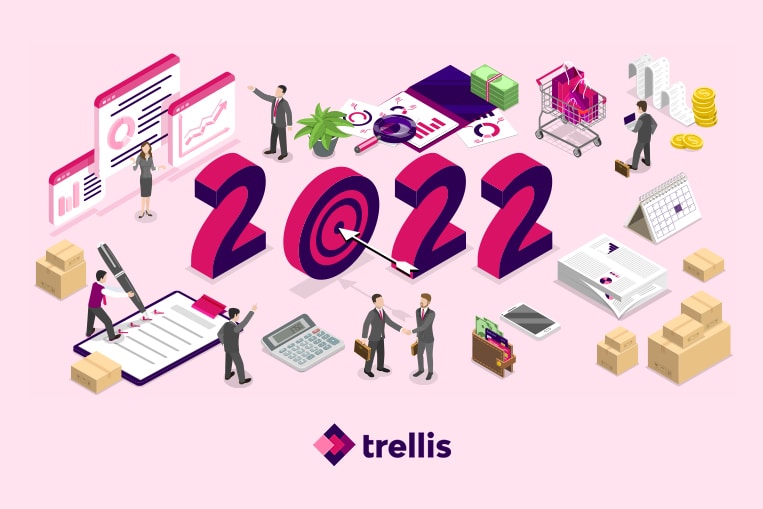The eCommerce share of retail witnessed tremendous growth during the pandemic, reporting a 2-5X increase in various countries. With the influx of brands and merchants vying for the attention of customers on marketplaces such as Amazon, Walmart, and much more, the competition is now stronger than ever. To accelerate eCommerce growth, businesses need to be spot on about many things. We reached out to industry experts and uncovered 12 emerging eCommerce trends for 2022 to help you fortify your growth strategy for the coming year and beyond.
1. Creating Omnichannel Experiences
The omnichannel approach is automation’s soulmate. They require and complement one another, resulting in a superior e-commerce experience for both buyers and merchants. To sell on marketplaces, stick to the tried-and-true method of investigating buying trends as well as consumer needs, concerns, and priorities, which are changing faster than ever in 2022.
You can make all of your channels – including marketplaces – into a single purchasing experience by offering consistent information across all of your sales channels, high-quality visual materials, and a consistent brand image. It’s also crucial to give them a method to transfer across channels: from online ads to the marketplace, from social media to your virtual store, and so on. We gained up to 166% more attention from the user with an omnichannel approach than with a single-channel sales approach.
– Brian Dean – Co-Founder, Backlinko & Exploding Topics
2. Multi-Brand and Multi-Product Strategies
One-size-fits-all no longer works in business. While your current offering may be selling well with Gen Xers, it’s essential to determine whether your products resonate with younger consumers such as Gen Zers. For this reason, eCommerce businesses must adopt a multi-brand and multi-product strategy.
We believe in building products around what people want and around the audience that we want to serve. We saw different opportunities to target different customer segments through a variety of retailers. However, we needed to specifically design our brands and products by first understanding that audience and what they are looking for. Our multi-brand and multi-product strategy enables us to have a portfolio of indie brands with a specific purpose rather than a mass brand that serves all people.
– Dino Ha – CEO, MBX & Kaja Beauty
3. Diversification of Payment Methods
The smallest details contribute to a customer’s delight. One of them is the variety of payment methods. It is the final step of the shopping procedure, and the absence of chosen payment methods may result in failure. Allow clients to pay in the manner they like and keep things straightforward. Apple Pay and Google Pay both appear to be excellent choices in this case.
Apart from traditional methods of payment such as credit card, bank transfer, or PayPal, there is a growing trend toward installment purchases. Twisto, for example, enables third-party transactions across central Europe. This allows you to spread the payment across three months. Additional services are provided throughout Europe through other companies. This may help in acquiring clients who could not purchase the products in casual situations.
– Gerrid Smith – Chief Marketing Office, Joy Organics
4. Augmented Reality
Gone are the days of the product on a white background or shot in a studio! These days, authentic visuals take precedence. Ritch and interactive content are becoming the new standards for eCommerce.
While brands like IKEA, Zara, or Atoll have deployed an Augmented Reality shopping experience, this is no longer reserved for big brands. In 2020, Shopify launched Shopify AR, an easy-to-use toolkit that allows businesses to create their own Augmented Reality experiences to showcase their products to customers. And it works: Shopify reports that interactions with products with AR content showed a 94% higher conversion rate than products without AR.
So expect more brands to take advantage of the capabilities of Augmented Reality in 2022 since the technology is becoming mature and affordable – and that more buyers will seek out this feature when making purchasing decisions.
– Hakim Bellahcene – General Manager eCommerce, Majid Al Futtaim
5. Video Content Automation
Content automation was a major trend this year with the emergence of several tools and platforms enabling businesses to streamline their content lifecycle. In 2022, we’ll continue to witness developments in content automation, especially when it comes to video. Given the proven value of video marketing for boosting conversion rates and growing sales for businesses, we’re noticing the launch of tech which can automate the creation of video content. These tools can stitch together product content and allow effective testing of videos to see what resonates with the target audience.
We’ve noticed that video content automation has opened new avenues for our clients, especially when showcasing their brands and products on marketplaces such as Amazon. Previously, many customers were apprehensive about investing the time and resources needed to make video content. However, with platforms such as Trellis, customers can generate video content and aim it towards the right customers through target discovery automation and bid optimization. We’ve noticed excellent results for our clients through video content automation, such as higher ROAS and conversion rates.
– Krishna Vemulapali – Co-Founder and CTO, Trellis
6. Shopping in Real-Time and Visual Commerce
The eCommerce trends for 2022 strongly revolve around participatory techniques of online product sales. By applying these techniques, vendors present realistic visuals that demonstrate whether the product satisfies the customer’s needs or not rather than using static images. Due to the fact that live shopping can take place on social media platforms, this trend can be considered as part of social commerce. It is based on the customer’s interaction with the seller or an influencer (who acts as an ambassador for the marketed company) during the live streaming.
Visual commerce is another popular trend in eCommerce, following live shopping. The objective is pretty similar, but the execution is a little more difficult. Customers can obtain an interactive 3D visualization of the product in visual commerce to get a better look at the product as part of the decision-making process. It will play a significant part in the fashion business, as shoppers will be able to visually try on clothing, headgear, spectacles, and other accessories to see if they fit or not. It may take place on social media (TikTok) or on the brand’s website via a custom-built and programmed app.
– Adam Fard – Founder & Head of Design, Adam Fard UX Agency
7. AI-Powered Product Photography
We believe in inclusivity and that people & technology go hand in hand. Automated product photography is a pioneering technology that reduces production time for fashion and product content by 50%. More and more businesses are now opting to create an online presence and are looking for cost-effective options and faster turnaround times to produce their content. Automated product photography could be the answer that they’re looking for.
– Quratulain Khalid – Director, Creative and Content, Brandverse
8. Mobile Friendly Websites
In 2022, you should boost your e-commerce website speed for the following reasons. First, Google is rolling out a Mobile-First plan that includes site speed. Google wants to be user-friendly. User experience is increasingly important to Google. By boosting your site speed, you are making Google’s users happy since they won’t have to wait for your site to load. If you want Google to show your site to its users, you need to make sure your loading time is not longer than two seconds.
If you want to increase your visibility in Google’s search engine, you need to increase your website’s loading time as well. Also, many search engine marketers sell on the internet. If people have to wait for your site to load, they will leave and buy from someone else. On the other hand, a happy consumer is bound to recommend your website. For all these reasons you need to boost your site speed. You’ll make Google happy; you’ll make consumers happy, and you will make yourself happy with the increased traffic, customers, and sales.
– Marc Stitt – Chief Marketing Officer (CMO), FMX
9. Google Ads for Local Inventory (LIA)
Google LIA is a revolutionary concept that is gaining traction. It is a technology that utilizes the customer’s location to highlight nearby products. Its marketing strategy is straightforward. According to Google, people who have the opportunity to physically inspect a product are more inclined to purchase it.
So, when a user searches for the desired product on Google, the local in-store available products are highlighted. As a result, the consumer has the option of visiting the store to inspect or try on the merchandise before buying, avoiding unneeded hassles (wrong size/color appears differently than on the photo, etc.). Additionally, merchants can also provide a pick-up later option.
– Sudhir Khatwani – Founder and Editor, The Money Mongers
10. Social Media Shopping
One upcoming trend for eCommerce is the rise of social media shopping. eCommerce businesses can reach online shoppers by setting up a social media account on platforms such as Facebook or Instagram. These platforms provide users with the tools to track metrics, sales, and customers making it easier for startups or small businesses to break into the industry.
eCommerce businesses can prepare by staying in the know. Social media and influencers are on a rise like never before and they hold a lot of power when it comes to driving customers or introducing products and brands. The best thing to do is make use of social media even if it may not seem relevant at the moment.
– Mehvish Patel – Zen Media PR Firm
11. Influencer Marketing
In 2021, the time people spent online grew greatly. Combined with the various lockdowns, this forced many to double down on their online presence. As many eCommerce brands currently battle for consumer attention. With platforms becoming more saturated in terms of paid media, Influencer marketing has started to play a bigger role.
This trend is expected to grow even bigger in 2022. With more and more eCommerce companies doubling down on their digital marketing efforts, influencer marketing has drawn the attention of many marketers. Mainly for its ability to reach the target audience “directly” and in a more natural way. There has also been a noticeable increase in the number of companies testing out Influencer marketing in efforts to boost the value provided by other content marketing efforts.
– Nikita Chen – CEO, LegitGrails
12. Personalized Product Demand
The pandemic has changed everything, most customers have to stay at home most of the time, which means they are more demanding from online shopping. Personalizing the product makes a difference in customer satisfaction due to customers’ exclusivity when purchasing the item. In exchange for this, 22% of consumers are ready to share their data. I believe that more brands will venture towards personalization as it makes the customers’ shopping experience easier and strengthens brand loyalty.
– Adam Korbl – Founder & CEO at iFax, Amplify Ventures, & Fill App
The latest mentor advice, industry news, and expert content to help upscale your eCommerce advertising strategy.



